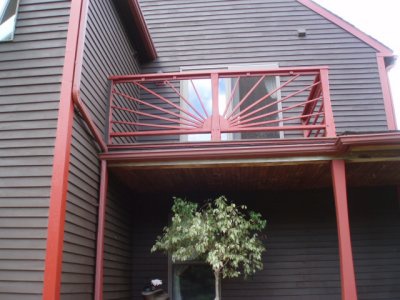

Project Blog
Small Timber Framed Building
Fishing Cabin
Screen Porch
Stair Modelling
Container Based Structures
Off the Grid Timber Frame
How Green is Timber Framing?
Trim Detail, Geometric Proportion, and Realistic Modelling
Small Timber Framed Building
Fishing Cabin
Screen Porch
Stair Modelling
Container Based Structures
Off the Grid Timber Frame
How Green is Timber Framing?
Trim Detail, Geometric Proportion, and Realistic Modelling
Trim detail, geometric proportion, and realistic modeling
My brother-in-law recently had some windows in his house replaced with some nice modern double-hungs. He was generally happy with the new windows, including the interior finish, but the exterior casing and general finish didn't quite work for him.
My brother-in-law recently had some windows in his house replaced with some nice modern double-hungs. He was generally happy with the new windows, including the interior finish, but the exterior casing and general finish didn't quite work for him.
I find this to be a pretty common situation; someone not exactly happy with a detail or details, but not
sure exactly why. I believe that the cause of this dissatisfaction stems from the same reason that so few
houses built in the last 150 years are really pleasing to the eye. In my opinion, this architectural
dysfunction results largely from a lack of attention to geometric proportion.
Prior to the early 1900's, there were few sources for manufactured building materials-sheetrock, plywood, modular windows and doors, cabinets, etc. Before modular building components entered the scene, architectural designers had fewer perceived constrictions on the design process. The key components to the design process were: 1- practical needs for space, 2-shelter, and 3-geometry. Geometry was the basic organizing principal; organizing simple shapes into patterns that worked in a practical sense and brought harmony to the vision of the observer. This had been the guiding principal in creating the best architecture for thousands of years. Unfortunately, this started to unravel with the advent of modular components; ceilings should be 8' high to accommodate sheetrock, doors need to be 6'-8" or 7', trim should be 3 ½" wide or 5 ½" wide because that's the size that it comes….. The past 100 years have produced so many pre-determined material and component sizes, and standardized construction techniques, that it's become a rare treat to see a house that's less than 100 years old and elegantly proportioned and detailed.
Back to the present situation (pre-rant); many houses that have some design challenges don't necessarily need major structural change to clean them up visually. In the case of my brother-in-law's house, the exterior façade has plenty of potential to come together by progressively simplifying and de-cluttering the trim and siding. Being able to realistically model changes to the façade can be really helpful in visualizing what a building can look like with simple changes. Here is a sample of cleaning up the window casings and surrounding siding and trim in the situation from the previous photo.
Prior to the early 1900's, there were few sources for manufactured building materials-sheetrock, plywood, modular windows and doors, cabinets, etc. Before modular building components entered the scene, architectural designers had fewer perceived constrictions on the design process. The key components to the design process were: 1- practical needs for space, 2-shelter, and 3-geometry. Geometry was the basic organizing principal; organizing simple shapes into patterns that worked in a practical sense and brought harmony to the vision of the observer. This had been the guiding principal in creating the best architecture for thousands of years. Unfortunately, this started to unravel with the advent of modular components; ceilings should be 8' high to accommodate sheetrock, doors need to be 6'-8" or 7', trim should be 3 ½" wide or 5 ½" wide because that's the size that it comes….. The past 100 years have produced so many pre-determined material and component sizes, and standardized construction techniques, that it's become a rare treat to see a house that's less than 100 years old and elegantly proportioned and detailed.
Back to the present situation (pre-rant); many houses that have some design challenges don't necessarily need major structural change to clean them up visually. In the case of my brother-in-law's house, the exterior façade has plenty of potential to come together by progressively simplifying and de-cluttering the trim and siding. Being able to realistically model changes to the façade can be really helpful in visualizing what a building can look like with simple changes. Here is a sample of cleaning up the window casings and surrounding siding and trim in the situation from the previous photo.
This took me about an hour using Vectorworks Architect CAD software. In another 15 minutes, I can
produce working drawings (plan, elevations, and details with dimensions). I basically tweaked the
dimensions of the window casings, adding a pediment at the top of the windows to both shed water and
improve the look, added sills, got rid of the wide water table along the deck, and added a copper flashing
detail to direct water away from the siding, trim, and deck. These are all relatively simple and inexpensive
steps. Another important upgrade, which would probably triple the life of the siding and trim, would be to
space the façade (siding and trim) away from the sheathing on furring strips, creating an air space to move
moisture away from the living area, and dry out the façade.
Marianne Cusato has written a great book on using and correcting architectural details and elements. It's called Get Your House Right. In my perfect world, designers and builders would embrace the sense of geometry and proportion that has produced so many of the truly classic buildings that have endured for hundreds and thousands of years. This doesn't only apply to traditional looking structures, Frank Loyd Wright's buildings were as geometrically elegant as some of the finest European cathedrals, Roman Amphitheatres and Shaker buildings.
Marianne Cusato has written a great book on using and correcting architectural details and elements. It's called Get Your House Right. In my perfect world, designers and builders would embrace the sense of geometry and proportion that has produced so many of the truly classic buildings that have endured for hundreds and thousands of years. This doesn't only apply to traditional looking structures, Frank Loyd Wright's buildings were as geometrically elegant as some of the finest European cathedrals, Roman Amphitheatres and Shaker buildings.
HOME -GALLERY - PROJECT BLOG - PHILOSOPHY - REVIEWS - TOOLCHEST - WINDSOR CHAIR - EMAIL